How to treat and avoid yellow cannabis leaves
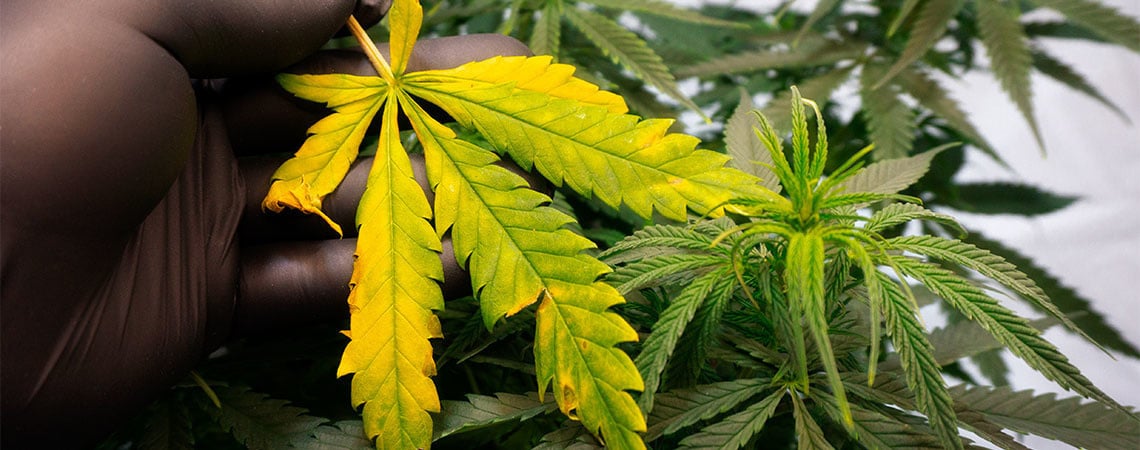
Yellow cannabis leaves can quickly spell trouble for your grow. Early action is key, whether it's a nutrient issue, light stress, or something else. This guide will help you quickly identify and fix the cause before your plants suffer. Read on to find out everything you need to know right now.
Noticing yellow leaves on your cannabis plants? Don't panic: here's how to fix it fast. Yellowing cannabis leaves can be a warning sign that your plants are under stress. Whether spotting slightly yellow tips, whole yellow leaves on a cannabis plant, or uneven coloration, understanding what causes these issues, and acting quickly once you spot them, can make all the difference in protecting your yield.
This guide is here to help you diagnose and treat the most common reasons cannabis leaves turn yellow. From nutrient deficiencies and watering problems to pH imbalance and environmental stress, we'll help you spot the signs early and restore your plants to full health. Whether you're growing indoors or outdoors, a beginner or an expert, knowing why your cannabis is turning yellow will make all the difference to your eventual harvest.
What causes yellow cannabis leaves?
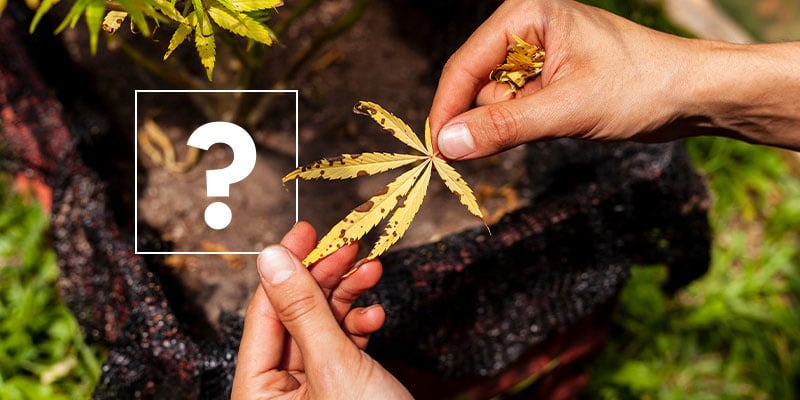
If your cannabis leaves are turning yellow, you're not alone. This is one of the most common issues growers face, and it can signal various problems, from a minor imbalance to a serious threat to the plant's overall health. The good news? Most causes of yellow cannabis leaves are easy to fix once correctly identified.
Below are the main culprits behind yellowing cannabis leaves, all of which we'll explore in detail later on:
- Nutrient deficiencies: Lacking essential elements like nitrogen, magnesium, or iron can cause the lower leaves to yellow first. Nutrient lockout due to incorrect pH levels is also a common issue. For a full breakdown, check out our nutrient deficiencies guide.
- Watering issues: Overwatering can drown roots, while underwatering leads to dehydration. Both will result in cannabis leaves yellowing or drooping.
- pH imbalance: If your growing medium's pH is too high or too low, it can prevent plants from absorbing nutrients even when they're present.
- Light stress: Too much direct light (or lights placed too close) can bleach and burn leaves, especially at the top of the canopy.
- Heat or cold shock: Sudden shifts in temperature, especially below 59°F or above 86°F, can cause yellow leaves on a cannabis plant, along with other growth issues.
By catching these signs early, growers can act quickly and preserve plant health and final yields.
How to identify yellowing symptoms by area
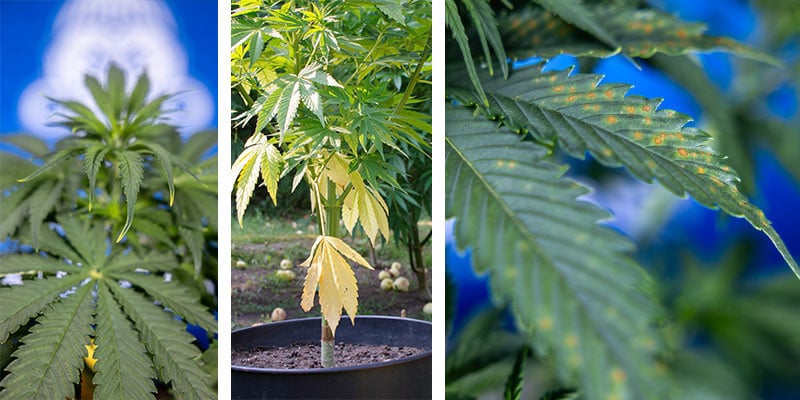
As you might expect, not all yellow cannabis leaves mean the same thing. Where and how discoloration appears can help pinpoint the exact issue. Here's how to read the signs, complete with pictures.
Tips and edges
If your cannabis leaf tips are turning yellow or are already yellowed, this is often a sign of nutrient burn, usually caused by overfeeding. In contrast, yellow leaf tips paired with curling or crispy edges might indicate light stress, wind burn, or potassium deficiency. These issues typically start at the edges of weed leaves and gradually spread inward.
Lower vs upper leaves
Yellow leaves on the lower part of the cannabis plant typically signal a mobile nutrient deficiency, such as nitrogen or magnesium, since the plant pulls resources from older leaves to support new growth. On the other hand, yellowing in upper leaves may be due to immobile nutrient issues (like iron or zinc) or light and heat stress from grow lights placed too close.
Color gradients and patterns
Uniform yellowing across entire leaves can suggest a root zone problem or pH imbalance. In contrast, patchy yellowing cannabis leaves with spots, blotches, or interveinal yellowing may be symptoms of pests, disease, or multiple overlapping issues. For more on these, see our guide on common cannabis diseases.
Diagnosing yellow cannabis leaves
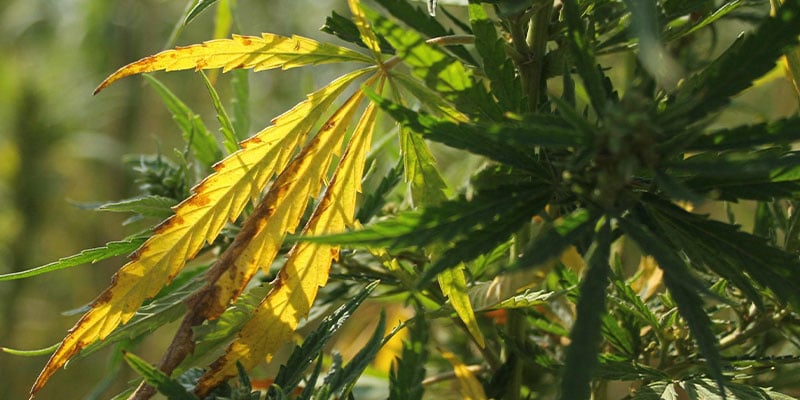
If you've spotted yellow leaves on your cannabis plant, you're likely dealing with one of a few key problems. While yellowing leaves can look similar at first glance, different causes produce distinct patterns and timing. Below, we break down the most common issues and how to address them effectively.
Nutrient deficiencies
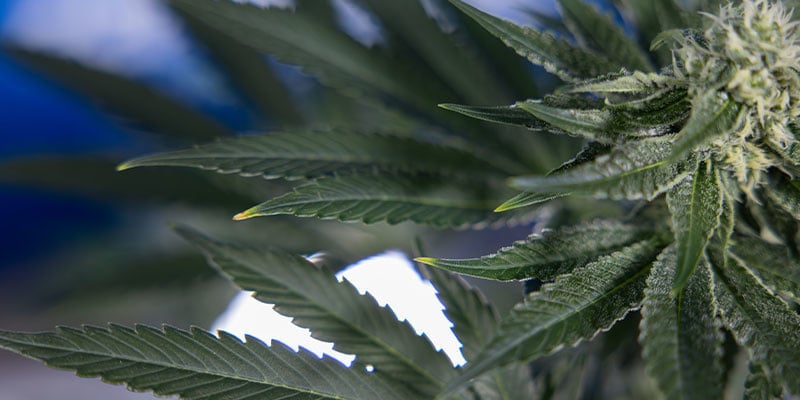
Nutrient shortages, especially nitrogen, magnesium, iron, and potassium, are some of the top causes of cannabis leaves turning yellow. These deficiencies may appear as pale lower leaves, interveinal yellowing, or yellowing of the leaf tips, depending on the element involved.
Read more: Zamnesia's nutrient deficiencies guide
Solution
- Identify the deficiency using leaf symptoms and plant stage.
- Use a complete cannabis nutrient mix with appropriate ratios.
- Ensure your growing medium is within the correct pH range to allow nutrient uptake.
- Avoid overfeeding, as excess can be just as harmful as deficiency.
Over/underwatering
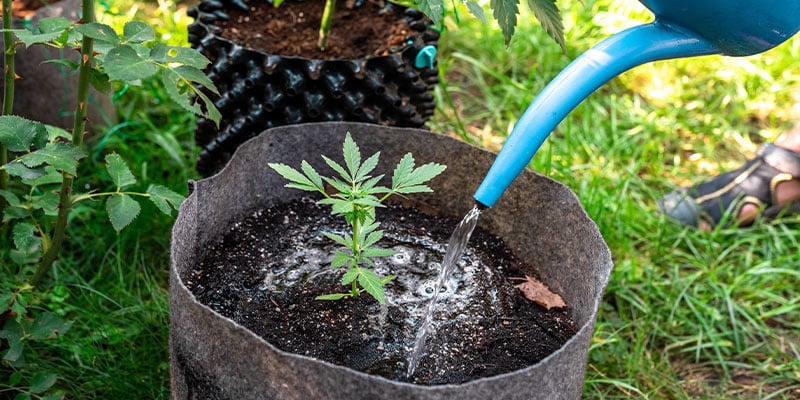
Too much or too little water can suffocate roots or cause stunted growth, leading to cannabis plants turning yellow, drooping, and poor performance. Overwatered plants often look swollen and limp, while underwatered ones appear dry and crispy.
Find out more: How much water do cannabis plants need?
Solution
- Water only when the top inch of soil feels dry.
- Lift pots to assess weight. Light = dry. Heavy = wet.
- Ensure pots drain well to prevent root rot and soggy soil.
pH imbalance
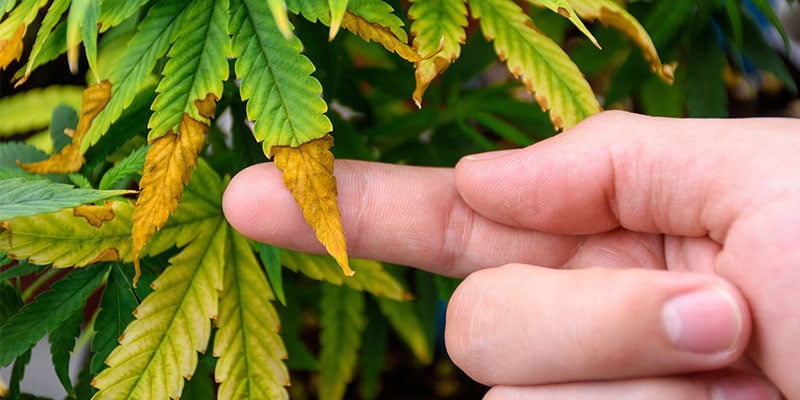
Even if you're feeding properly, incorrect pH levels can block nutrient absorption, causing cannabis leaves to yellow despite plenty of nutrients in the soil or hydroponic solution.
Find out more: How to adjust pH when growing cannabis.
Solution
- Measure pH regularly using a soil or solution meter.
- Aim for a range of 6.0–7.0 in soil, or 5.5–6.5 in hydro.
- Use pH up or down products to maintain balance.
Light stress
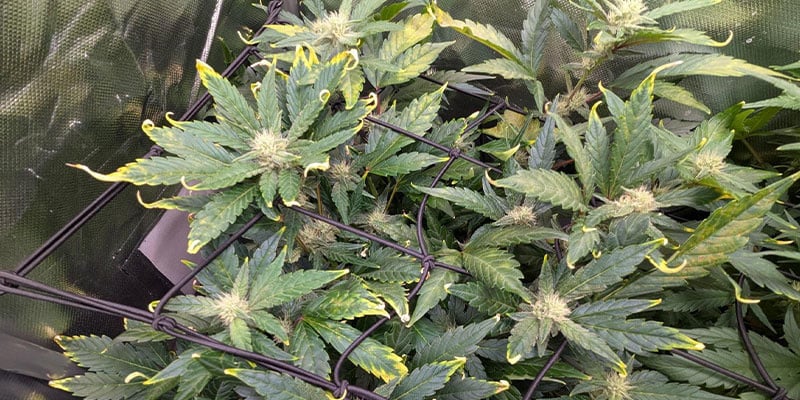
Too much light or poor light positioning can bleach or burn leaf tips and edges, especially near the top of the canopy. This causes yellow tips on leaves that cannabis growers often misdiagnose as nutrient issues.
Read more: Optimal distance between lights and plants.
Solution
- Adjust light height based on intensity (LEDs can be particularly strong).
- Use a PAR meter to assess even light coverage.
- Rotate plants to avoid hot spots.
Heat/cold shock
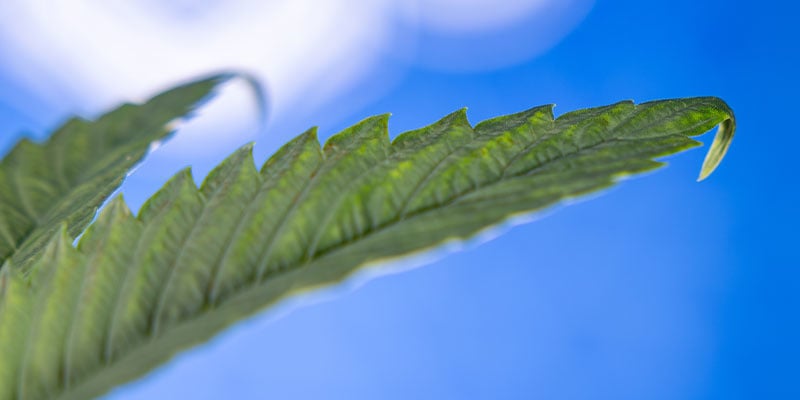
Temperature extremes, especially in grow tents or greenhouses, can lead to curling, yellowing, or brown edges. If your cannabis yellow tips appear alongside wilting or slowed growth, check your environment. In some cases, prolonged heat stress may also cause foxtailing, where buds develop thin, tower-like shapes instead of compact flowers.
Discover more: Is foxtailing good or bad?
Solution
- Keep temps around 68–82°F (lights on) and 61–72°F (lights off).
- Avoid placing plants near cold drafts or heat sources.
- Use fans and heaters to maintain stable temps.
Pests
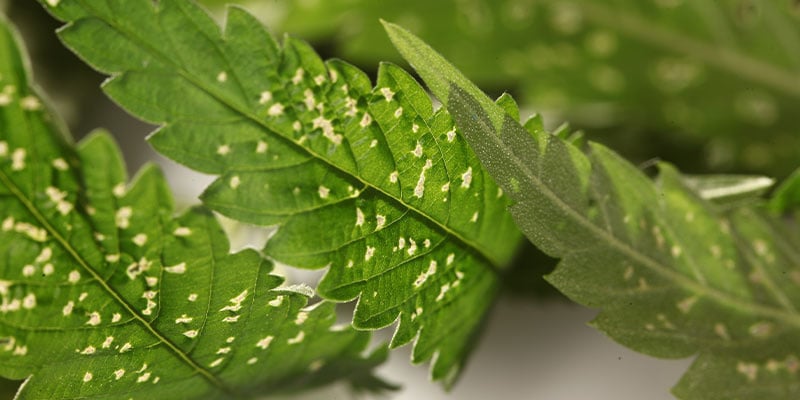
Tiny intruders like spider mites, aphids, and fungus gnats can damage leaves, leaving behind yellow patches or spots. If your leaves have holes, sticky residue, or webbing, pests may be the root of the problem.
Read more: Common insect pests in cannabis grows.
Solution
- Inspect leaves closely (top and underside).
- Use neem oil, insecticidal soap, or predatory insects.
- Maintain cleanliness and airflow to prevent infestations.
Cannabis diseases
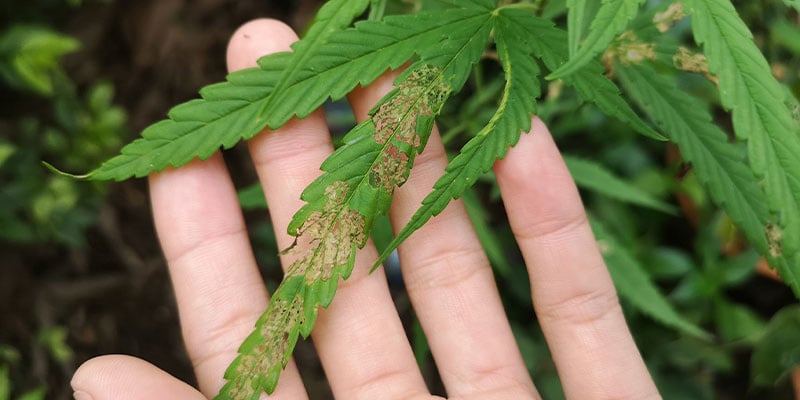
Fungal infections like Fusarium, root rot, and leaf septoria can all lead to cannabis leaves yellowing, curling, or drying off. A disease could be to blame if yellowing appears quickly and spreads rapidly.
Find out more: Common cannabis diseases.
Solution
- Remove affected foliage immediately.
- Improve airflow and reduce humidity.
- Consider using natural fungicides or preventative sprays.
Diagnosing yellow leaves based on growth stage
Not all yellow cannabis leaves are created equal, and neither are the plants' needs during the different stages of growth. Recognizing when the issue appears in your grow cycle can help you zero in on the cause more quickly. Below is a breakdown of what to look for and how to respond during each phase of development.
Seedling stage

At this fragile stage, cannabis leaves turning yellow usually point to environmental stress or overwatering. Because seedlings have small root systems and minimal nutrient demands, it's easy to cause harm with too much love.
Common solutions
- Avoid overwatering: Keep soil lightly moist, not soggy.
- Use gentle light: Fluorescents or low-intensity LEDs work best; avoid intense direct light.
- Check humidity: Maintain 65–70% RH for optimal growth.
- Skip fertilizer: Most soil has enough nutrients for the first 1–2 weeks.
Vegetative stage
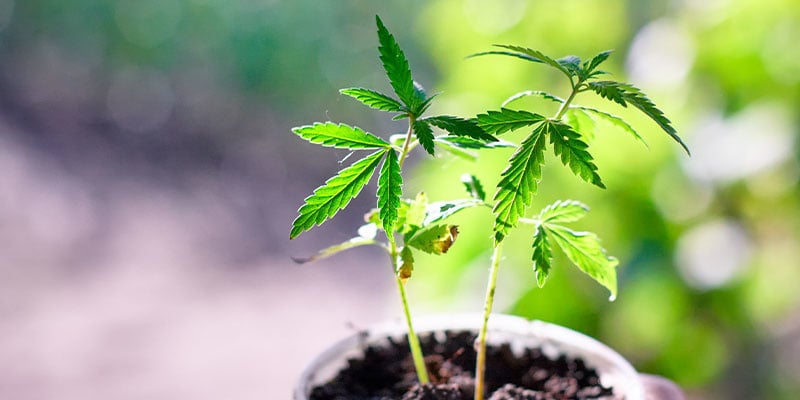
During veg, your plant demands more nitrogen and magnesium for rapid green growth. Cannabis leaves yellowing during this stage typically indicate a nutrient deficiency or a pH issue impacting nutrient uptake.
Common solutions
- Feed appropriately: Use a veg-specific nutrient mix high in nitrogen.
- Monitor pH: Aim for 6.0–7.0 in soil and 5.5–6.5 in hydroponics.
- Watch watering: Allow the top layer of soil to dry slightly between waterings.
- Ensure adequate light: Insufficient light can weaken lower growth, causing yellow leaves on cannabis near the base.
Flowering stage
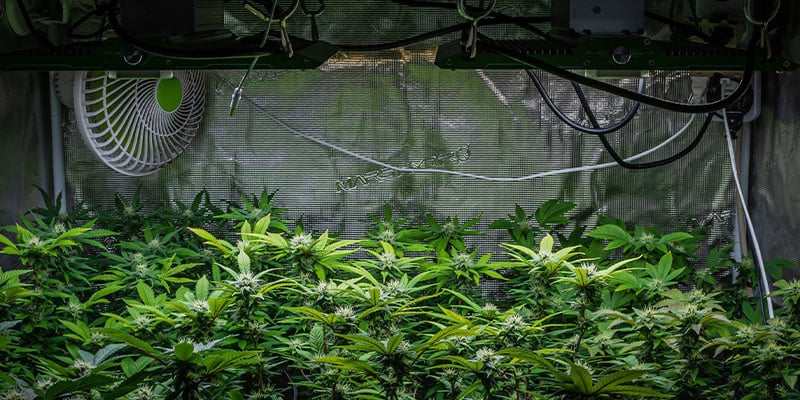
When plants transition to bloom, their nutrient needs also shift; phosphorus and potassium become critical. It's also normal for lower cannabis leaves to turn yellow and die off naturally as the plant redirects energy to buds. However, if yellow tips on cannabis leaves or yellowing across the canopy occur, that could mean trouble.
Common solutions
- Switch to bloom nutrients: Reduce nitrogen, increase phosphorus and potassium.
- Check for nutrient lockout: Flushing the medium may help restore balance.
- Watch humidity: Lower RH to 40–50% to prevent mold and nutrient issues.
- Don't panic about minor yellowing: Yellow tips on fan leaves during late flower is often part of natural aging.
Prevention tips to avoid yellow leaves
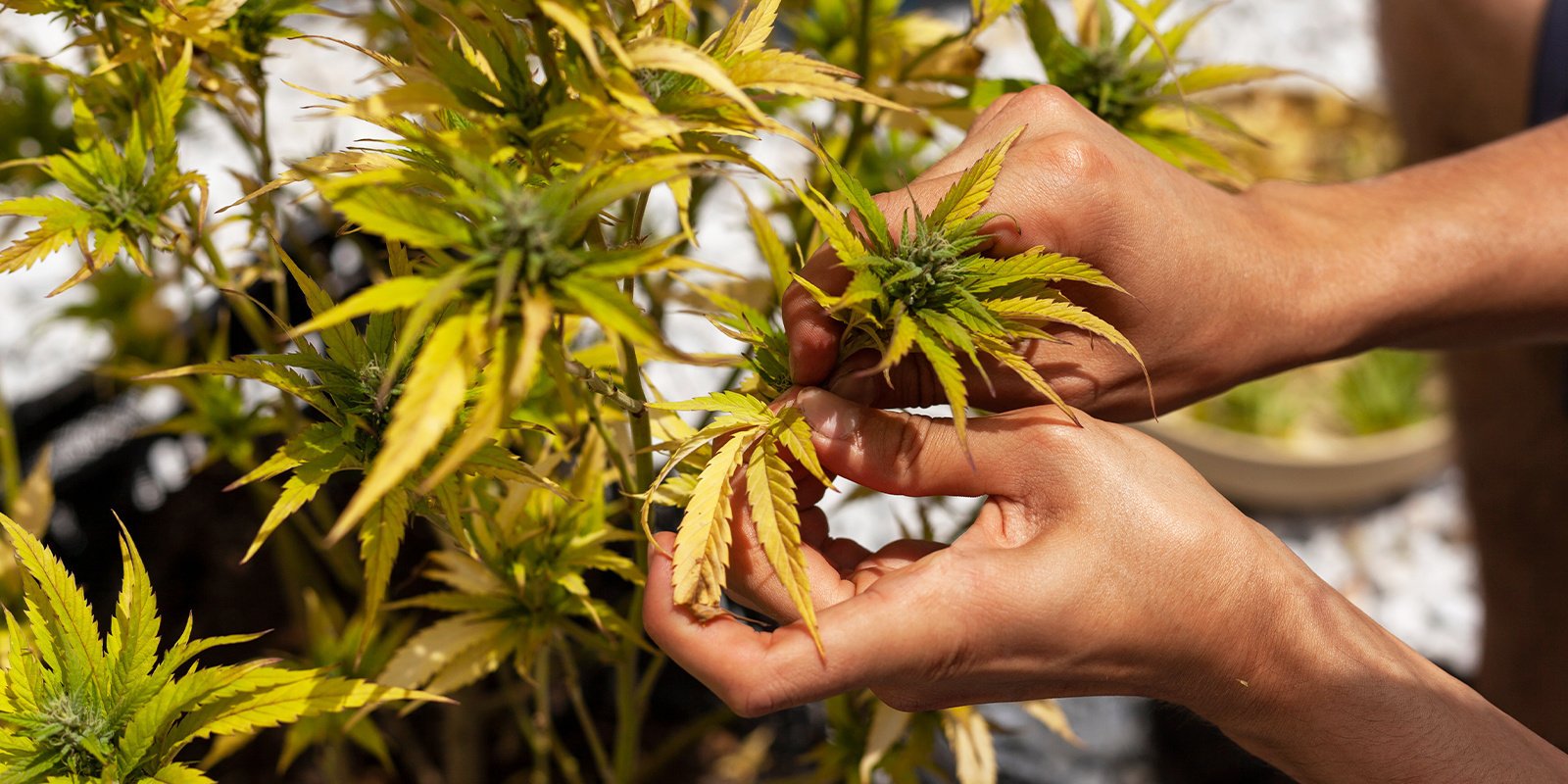
The best way to avoid marijuana leaves turning yellow is to stay ahead of the problems. Prevention not only protects your harvest but also saves you time, money, and stress further down the line. Here's how to reduce the chances of yellow cannabis leaves showing up.
Monitor environment: Humidity & temperature
Fluctuations in temperature and humidity can quickly lead to yellow leaves on your plants, especially during the seedling and flowering stages. Here are some top tips for maintaining the ideal environment for your plants.
- Keep daytime temps between 68–82°F and nighttime around 61–72°F.
- Maintain 65–70% humidity during the seedling stage, and gradually lower it to 40–50% during flowering.
- Use a reliable hygrometer/thermometer combo like the Hygrometer & Thermometer to track conditions accurately.
Use quality soil and nutrients
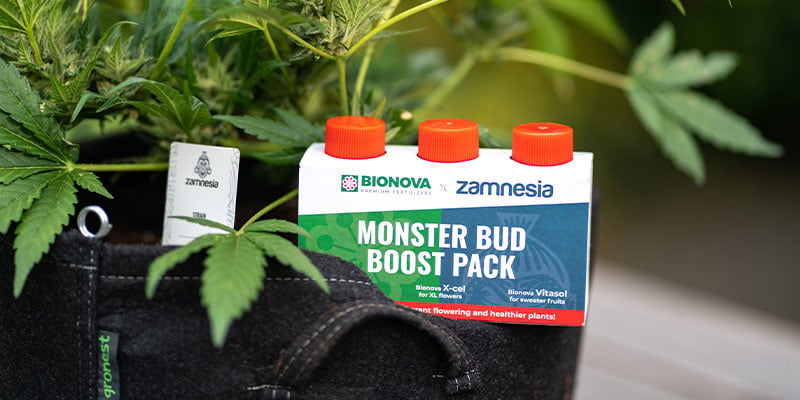
Poor-quality soil can cause nutrient lockout or create pH imbalances: two major reasons for yellowed cannabis leaves and chlorosis. Be sure to pick soil with balanced pH and aeration and feed with trusted nutrient formulas.
- Test your pH regularly with tools like Zamnesia pH test strips.
- Start with light feeding and gradually increase based on plant needs and stage of growth.
Proper watering techniques
Overwatering and underwatering are frequent and common causes of yellowing cannabis leaves, especially for beginner growers.
- Always let the top inch of soil dry before watering again.
- Ensure pots have good drainage to avoid soggy roots.
- Observe leaf posture. If leaves are drooping and yellow, it's likely to be a water-related issue.
Light positioning
Light stress can bleach leaves or burn tips. If your cannabis leaf tips are turning yellow near the top of the plant, poor light positioning may be to blame.
- Adjust lights to the correct height based on your specific model and wattage.
- Use adjustable hangers or sliders to fine-tune light distance as plants grow.
- Ensure even coverage across the canopy to avoid hot spots.
When are yellow leaves normal?
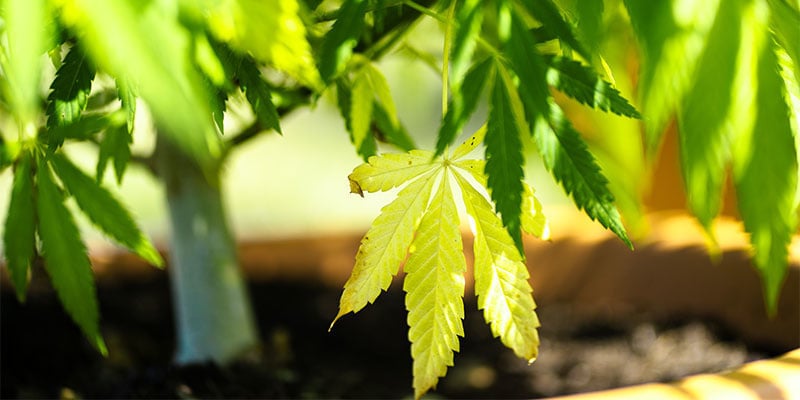
Contrary to what we've uncovered in this guide, not every instance of cannabis leaves yellowing is a sign of trouble. In fact, yellow leaves can be a completely natural part of the plant's life cycle, especially as it nears maturity. As the cannabis plant grows, older fan leaves at the bottom may yellow and drop off. This is normal and allows the plant to redirect energy to new growth. Conversely, during the final weeks of bloom, it's common to see yellow leaf tips or full leaves as the plant begins senescence, a natural “winding down” before harvest.
Simply put, if yellowing appears in a predictable, lower-down pattern and coincides with late flowering, you likely don't need to worry.
Should I pluck my yellow leaves off the cannabis plants?
This is a very common question among growers. If yellow cannabis leaves are clearly dying, dry, and fall off with a gentle tug, it's completely safe to remove them. However, avoid pulling off leaves that are only partially yellow or still serving a purpose, as leaves are still useful for photosynthesis unless fully degraded.
When to remove yellow leaves
- They're completely yellow, dry, and crumble easily.
- They block light to healthy bud sites or airflow within dense canopies.
- They show signs of disease or pests and could spread problems.
When to leave them alone
- They're only slightly yellow or discolored at the tips.
- They're located on healthy branches and still contributing to plant function.
Yellow leaves? You've got this
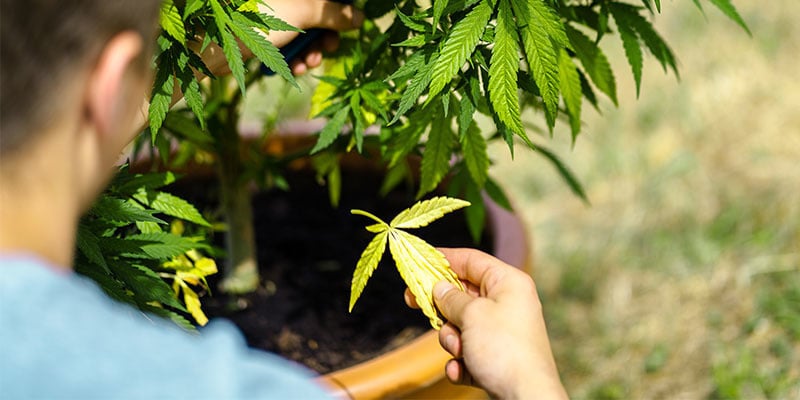
As we've discovered, yellowing cannabis leaves can mean many things, from a simple case of overwatering to deeper issues such as nutrient lockout or pest infestations. By paying close attention to when and where the yellowing occurs, whether at the tips, edges, lower or upper leaves, you can narrow down the cause and take swift, effective action. Remember: early intervention is key to keeping your plants healthy and your harvest on track.
It's also important to remember that not all yellow leaves are a bad sign. If you're late in the flowering stage and noticing leaves fading from green to yellow, your plant might simply be naturally reaching the end of its life cycle.
To support vibrant, resilient plants from the start, use high-quality genetics and reliable growing supplies. Check out Zamnesia's premium selection of cannabis seeds and grow with confidence. No more second-guessing why your cannabis leaves are turning yellow.





 United States
United States










